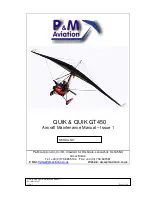
40
Section 07
Motorised flight
reaches its apex, the pilot must turn
around into the direction of flight and
can run into the wind and take off. As
with a forwards launch, the correct
combination of brake and throttle is
important to achieve the best speed
and climb.
WARNING
The pilot must work actively to keep
the glider on the ground in higher
wind speeds (from approx. 6 m/s),
otherwise the glider may rise above
the pilot unintentionally which can
lead to the pilot being lifted off,
turned and dragged away.
With the reverse launch, you should
observe the following special features
in addition to the points given under
“Forwards launch”:
•
the correct technique for clipping
in, inflation, and turning around is
very important for the reverse
launch. The pilot must master these
before points before attempting
them with the motor running
•
always turn around steadily and
briskly into the right direction
•
when clipping in with risers crossed,
always check that they are not
swapped over or twisted in the
carabiners
Climbing
Once you are airborne, you may notice
the counter-torque i.e. the glider wants
to turn against the direction in which
the propeller is turning. Focus on a
fixed point in the distance and
maintain your direction by counter-
steering.
After launch, first fly into the wind and
let the MIURA RS pick up speed.
Do not climb with too great an angle of
attack. Select the rev speed and brake
line use so that there is enough speed
to keep sufficient reserve before stall
point.
If the angle of attack is too high when
you are climbing, the glider could stall
if there is any further increase in the
angle of attack e.g. a vertical gust. A
further reason for keeping the climb
gentle is if there were motor failure at
low altitude. If this happened, you
should always be in a position where
you are able to land safely.
Counter-torque oscillation
Certain combinations of take-off
weight, thrust from the motor and
propeller size can cause pendulum
motions. If this happens, the pilot can
be pushed to one side during flight
because of the counter-torque and the
gyroscope effect. The pilot then swings
back into his original position because
of his weight, only to then swing up
even further.
The pilot can do the following to
counter the pendulum motion:
•
alter the throttle setting
•
counter the pendulum effect
by pulling slightly on the
brakes
•
weight-shift in the harness
and/or adjust the harness
position if it has suitable
adjustment options (cross-
strap)
Pendulum motions generally occur at
high revs and if the propeller has a
large diameter. Attempts to steer by
the pilot can increase the pendulum
motion if they are over-exaggerated
and not synchronised. If there are
uncontrolled pendulum motions, the






































